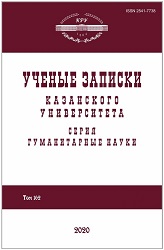Гигиеническая культура номадов евразийских степей XIII – XV вв.
Hygiene Culture of Nomads in the Eurasian Steppes during the 13th–15th Centuries
Author(s): Lenar Firgatovich AbzalovSubject(s): Customs / Folklore, Ethnohistory, Social history, 13th to 14th Centuries, 15th Century
Published by: Казанский (Приволжский) федеральный университет
Keywords: personal hygiene; hygiene procedures; nomads; Great Steppe; states of Genghis Khan’s descendants;
Summary/Abstract: Based on a comprehensive study of various written sources and ethnographic materials, this paper considers some aspects of personal hygiene of nomads, who lived in the Eurasian steppes during the 13th–15th centuries, i.e., primarily in the states of Genghis Khan and his descendants. Regarding both similar living conditions and ethnocultural situation, as well as the important role of traditions in the nomadic society of Central Asia, the data of the ethnographic sources about the everyday life of nomads during the subsequent eras (in the 16th–20th centuries) were extrapolated to the nomadic society of Genghis Khan’s states. The body hygiene procedures (associated with face, hands, and head hair) were analyzed. The main personal hygiene products (combs, scissors, mirrors, cosmetics (white paint), soap, etc.) were described. It was revealed that the hygiene culture of nomads in the Eurasian steppes developed under the influence of the following objective factors: nature and climate, economic and living conditions. In this process, the faith-related factors and the worldview were also critical, mostly in Ulus and Jochi. The hygiene knowledge and practices of all nomads were generally similar, but there were some specific features associated with their ethnocultural background.
Journal: Ученые записки Казанского университета. Серия Гуманитарные науки
- Issue Year: 162/2020
- Issue No: 6
- Page Range: 22-34
- Page Count: 13
- Language: Russian

